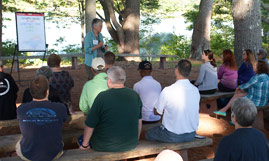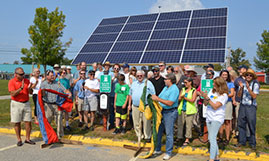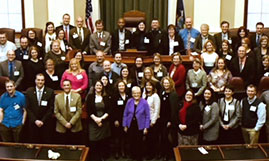AUGUSTA, Maine — September 25, 2018 FOR/Maine (Forest Opportunity Roadmap), a broad coalition working to diversify the state’s wood products businesses, attract capital investments, and develop greater economic prosperity for communities impacted by recent mill closures, announces an action plan to grow Maine’s forest economy from the current $8.5 billion (annual) to $12 billion by 2025.
The Roadmap outlines how the industry will achieve the projected 40 percent growth, much of it coming from new markets for the state. The sector will build on traditional strengths like saw logs and paper, and add new layers of innovative products – including eco-friendly chemicals, bio-degradable plastics, and medical and technical products made from nanocellulose – many of which can be made from the residuals of other wood manufacturing processes.
“Maine has an incredible, sustainable forest resource, including an abundance of moderately priced softwood raw material in an area with existing harvesting and logistics infrastructure,” says Patrick Strauch, FOR/Maine Co-Chair and Executive Director of the Maine Forest Products Council. “In the past, this resource went primarily to papermaking and saw logs. While these products will remain the backbone, the industry will look much more diverse over the next few years. Maine’s trees will be inputs to everything from textiles, to medical devices, to biofuel. Anything made from plastic can also be made from a wood base.”
The Roadmap is the culmination of two years of coordinated research and strategy development, informed by extensive data, global benchmarking, and industry expertise. It reveals Maine’s competitiveness in new global markets, and outlines five goals and 17 matched strategies to realize the opportunity, and build a more diverse $12 billion forest economy annually:
- Goal 1: Invest, Innovate, Grow – Sustain and grow Maine’s existing and emerging forest products economy, reaching $12 Billion in economic impact by 2025. This includes attracting investment in the forest products industry, marketing Maine’s bioeconomy to national and global audiences, and accelerating innovation in forest products and applications to leverage Maine’s leadership position within the industry.
- Goal 2: Manage Sustainably – Manage the wood resource using sustainable and responsible forest management practices. This is informed by accurate and current data about Maine’s forests.
- Goal 3: Develop Workforce – Prepare workforce for the future of the forest products economy. This entails making sure that current workers have the skills they need and that Maine is positioned to attract and prepare the necessary workforce for emerging products and new opportunities.
- Goal 4: Support Communities – Increase prosperity in Maine forest economy communities, especially those in rural areas and those affected by mill closures. This involves coordinated efforts across local, regional, state, and federal entities to attract capital investment.
- Goal 5: Coordinate & Persist – Organize the forest products industry with committed public sector partners, including the University of Maine, to implement the vision and goals. This requires a sustained, collaborative, and coordinated effort across local, regional, state, and federal entities.
“Maine’s forests are a major renewable resource. With the right next steps, like investment-friendly regulations and policy support, the state is in a position to grow a sustainable economy built on bio-based production,” says Jeffrey Hatcher, managing director of Indufor North America, an international consulting firm that specializes in the forestry sector and conducted the global market analysis. “Innovation, collaboration, and an eye toward long-term sustainability are key ingredients to success. We are very excited to see where Maine goes from here.”
The project has been strongly supported by industry leaders, university researchers, community and civic leaders, as well as Maine’s Congressional Delegation, which was instrumental in securing U.S. Economic Development Administration (EDA) support for the project. The recommendations also benefited from key input from state agencies.
“Maine has a huge opportunity to expand the value-chain of products we make from wood, and this Roadmap is a big step in the right direction,” says Steve Shaler, Director and Professor at the University of Maine School of Forest Resources. “The University of Maine is recognized as a global leader in forest products innovation, and we have new research coming online. We will be partnering with industry more closely to commercialize these innovations.”
Communities and towns throughout Maine who have been acutely affected by recent mill closures are now coming together and rebounding in a historic effort to re-envision a strong future. “We are creating the conditions for diversification and new investment to welcome new growth and good job opportunities to our region,” said Peggy Daigle, selectman in East Millinocket and retired town and city manager for four different paper mill communities, including Millinocket, Old Town, East Millinocket, and Lincoln. “This is both an exciting and critical time in our state’s forestry history.”
FOR/Maine sees the enormous opportunity to create the next great era of Maine forestry but in order to seize this economic growth for the state, there is an imperative need for partners across all sectors to work together to create the conditions that would attract new investment. This includes ongoing coordination and cooperation between industry, state government, and forest communities, supported by the Maine public.
The coalition has identified several Maine businesses and community members who are playing an active role in ensuring a future for the forest economy. If you would like to contact the subject matter experts associated with the following storylines or to arrange an interview with any of the FOR/Maine members, coalition chairs Patrick Strauch, Yellow Light Breen, or Steve Schley, please contact Claire Jeffers or Kathy Shannon.
Biobased chemical products can lead Maine to second golden age of forestry:
- Innovation, research & sustainability in forest products at the University of Maine
- Innovation, research & sustainability in forest products at the University of Maine
- Maine’s largest mills invest for the future
- Family-owned forestry businesses embrace change
- Maine mill towns find a new path forward
- How collaboration is at the root of change in Maine’s forest industry
CONTACT
- Claire Jeffers
Public Relations
Better Yet Studio
Claire@better-yet.com - Kathy Shannon
Director of Engagement & Communications
Maine Development Foundation
kshannon@mdf.org
207-400-1828
ABOUT FOR/MAINE
FOR/Maine is a unique cross-sector collaboration between industry, communities, government, education, and non-profits, which have come together to realize the next generation of Maine’s great forest economy. The development of the coalition’s action plan is supported by funding from the U.S. Economic Development Administration and the U.S. Department of Agriculture and was created to assess Maine’s current industry, assets and readiness and determine a
strategy to capitalize on new opportunities. FOR/Maine is combining collaborative actions, innovation, market and resource management expertise, and reliable data to guide smart and successful investment and market expansion in the forest economy.









